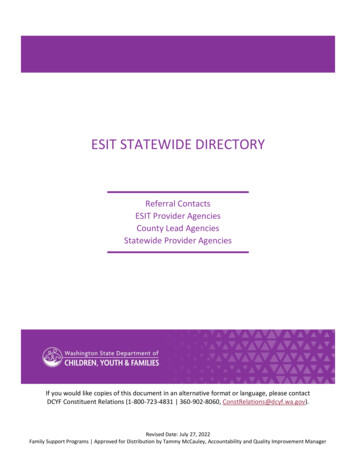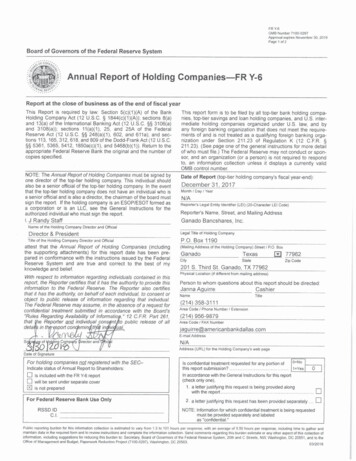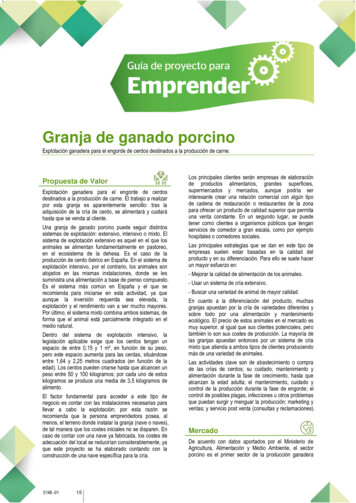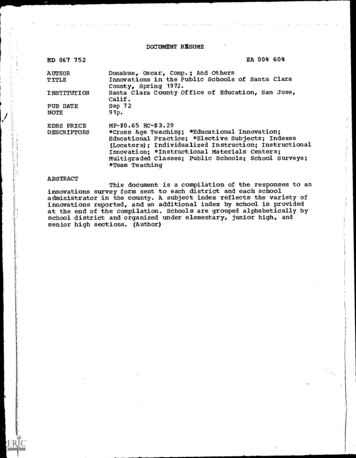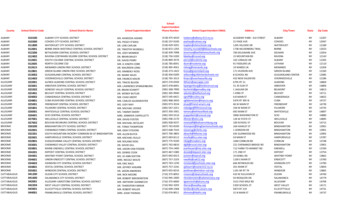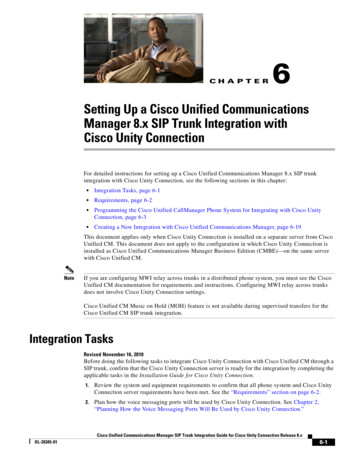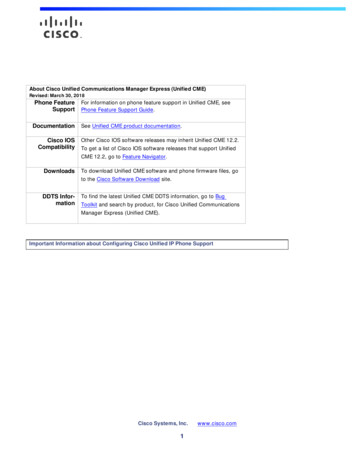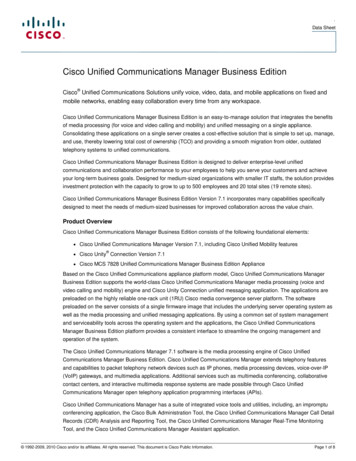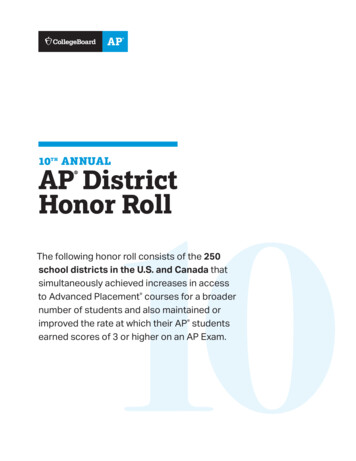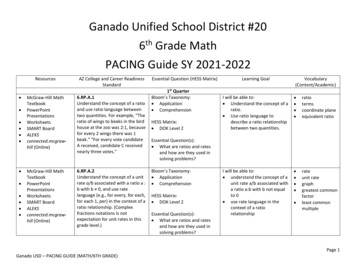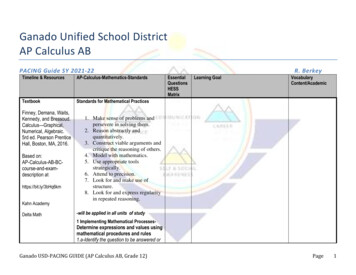
Transcription
Ganado Unified School DistrictAP Calculus ABPACING Guide SY 2021-22Timeline & Standards for Mathematical PracticesFinney, Demana, Waits,Kennedy, and Bressoud.Calculus—Graphical,Numerical, Algebraic.5rd ed. Pearson PrenticeHall, Boston, MA, 2016.Based on:AP-Calculus-AB-BCcourse-and-examdescription athttps://bit.ly/3bHq6kmKahn AcademyDelta MathR. BerkeyEssentialQuestionsHESSMatrixLearning GoalVocabularyContent/Academic1. Make sense of problems andpersevere in solving them.2. Reason abstractly andquantitatively.3. Construct viable arguments andcritique the reasoning of others.4. Model with mathematics.5. Use appropriate toolsstrategically.6. Attend to precision.7. Look for and make use ofstructure.8. Look for and express regularityin repeated reasoning.-will be applied in all units of study1 Implementing Mathematical Processes-Determine expressions and values usingmathematical procedures and rules1.a-Identify the question to be answered orGanado USD-PACING GUIDE (AP Calculus AB, Grade 12)Page1
problem to be solved (not assessed).1.b-Identify key and relevant information toanswer a question or solve a problem (notassessed)1.c-Identify an appropriate mathematicalrule or procedure based on theclassification of a given expression (e.g.,Use the chain rule to find the derivative of acomposite function).1.d-Identify an appropriate mathematicalrule or procedure based on the relationshipbetween concepts (e.g., rate of change andaccumulation) or processes (e.g.,differentiation and its inverse process, antidifferentiation) to solve problems.1.e-Apply appropriate mathematical rules orprocedures, with and without technology1.f-Explain how an approximated valuerelates to the actual value.2-Connecting Representations-Translatemathematical information from a singlerepresentation or across multiplerepresentations.2.a-Identify common underlying structuresin problems involving different contextualsituations.2.b-Identify mathematical information fromgraphical, numerical, analytical, and/orverbal representations.2.c-Identify a re-expression of mathematicalinformation presented in a givenrepresentation.Ganado USD-PACING GUIDE (AP Calculus AB, Grade 12)Page2
2.d-Identify how mathematicalcharacteristics or properties of functions arerelated in different representations2.e-Describe the relationships amongdifferent representations of functions andtheir derivatives.3-Justification-Justify reasoning andsolutions.3.a-Apply technology to develop claims andconjectures (not assessed).3.b-Identify an appropriate mathematicaldefinition, theorem, or test to apply3.c-Confirm whether hypotheses orconditions of a selected definition, theorem,or test have been satisfied3.d-Apply an appropriate mathematicaldefinition, theorem, or test.3.e-Provide reasons or rationales forsolutions and conclusions3.f-Explain the meaning of mathematicalsolutions in context3.g-Confirm that solutions are accurate andappropriate.4-Communication and Notation-Usecorrect notation, language, andmathematical conventions tocommunicate results or solutions.4.a-Use precise mathematical language4.b-Use appropriate units of measure.4.c-Use appropriate mathematical symbolsand notation (e.g., Represent a derivativeusing f'(x), y', dy/dx)4.d-Use appropriate graphing techniques.4.e-Apply appropriate rounding procedures.Ganado USD-PACING GUIDE (AP Calculus AB, Grade 12)Page3
BIG IDEA 1: CHANGE (CHA) Usingderivatives to describe rates of change ofone variable with respect to another orusing definite integrals to describe the netchange in one variable over an interval ofanother allows students to understandchange in a variety of contexts. It is criticalthat students grasp the relationshipbetween integration and differentiation asexpressed in the Fundamental Theorem ofCalculus—a central idea in AP Calculus.BIG IDEA 2: LIMITS (LIM) Beginning witha discrete model and then considering theconsequences of a limiting case allows usto model real-world behavior and todiscover and understand important ideas,definitions, formulas, and theorems incalculus: for example, continuity,differentiation, integration.BIG IDEA 3: ANALYSIS OF FUNCTIONS(FUN) Calculus allows us to analyze thebehaviors of functions by relating limits todifferentiation, integration, and infiniteseries and relating each of these conceptsto the others.Unit 0- prerequisitesfor calculus 10 daysUnit 1-Limits andContinuityGanado USD-PACING GUIDE (AP Calculus AB, Grade 12)0.1 linear functions0.2 functions and graphs0.3 exponential functions0.4 parametric functions(Bc)0.5 inverse functions and logarithms0.6 trigonometric functions0.7 rational functions1.1 Introducing Calculus: Can Change Occurat an Instant?Unit 1Page4
23 daysGanado USD-PACING GUIDE (AP Calculus AB, Grade 12)1.2 Defining Limits and Using LimitNotation1.3 Estimating Limit Values from Graphs1.4 Estimating Limit Values from Tables1.5 Determining Limits Using AlgebraicProperties of Limits1.6 Determining Limits Using AlgebraicManipulation1.7 Selecting Procedures for DeterminingLimits1.8 Determining Limits Using the SqueezeTheorem1.9 Connecting Multiple Representations ofLimits1.10 Exploring Types of 3 Discontinuities1.11 Defining Continuity at a point1.12 Confirming Continuity over anInterval1.13 Removing 1Discontinuities1.14 Connecting infinite limits and verticalasymptotes1.15 Connecting infinite limits andHorizontal asymptotes1.16 Working with the Intermediate ValueTheorem (IVT)Key IdeasAverage andInstantaneousSpeedDefinition of limitProperties of limitsOne-sided and Twosided limitsSqueezeFinite limits as x /- infinitySqueeze TheoremRevisitedEnd BehaviorModels“Seeing Limits” as x /- infinityContinuity as sitesIntermediate valuetheorem forcontinuousfunctionsAverage Rates ofChangeTangent to a CurveSlope of a CurveSpeed RevisitedPage5
Unit-2Differentiation:Definition and BasicDerivative Rules 14 daysGanado USD-PACING GUIDE (AP Calculus AB, Grade 12)2.1 Defining Average and InstantaneousRates of Change at a Point2.2 Defining the Derivative of a Functionand Using Derivative Notation2.3 Estimating Derivatives of a Function ata Point2.4 Connecting Differentiability andcontinuity: determining when derivativedo & don’t exist.2.5 Applying the Power Rule2.6 Derivative Rules: Constant, Sum,Difference, and constant Multiple2.7 Derivatives of cos x, sin x, e x , andln(x)2.8 The Product Rule2.9 The Quotient RuleNormal to a CurveSpeed revisitedSensitivityUnit 2Definition ofDerivativeNotationRelationshipbetween the graphsof f and f’Graphing thederivative fromdataOne-sidedDerivativesHow f‘(a) might failto existDifferentiationimplies locallinearityNumericalderivatives on acalculatorDifferentiabilityimplies continuityIntermediate valuetheorem forderivativesPositive integerPowers, multiples,sums anddifferencesProducts andquotientsPage6
Unit-3Differentiation:Composite, Implicit,and InverseFunctions 11 daysGanado USD-PACING GUIDE (AP Calculus AB, Grade 12)3.1 The Chain Rule3.2 Implicit Differentiation3.3 Differentiating Inverse Functions3.4 Differentiating Inverse TrigonometricFunctions3.5 Selecting Procedures for CalculatingDerivatives3.6 Calculating Higher Order DerivativesNegative Integerpowers of xSecond higherorder derivativesInstantaneousrates of changeMotion along a lineSensitivity tochangeDerivatives inEconomicsDerivative of thesine functionDerivative of thecosine functionSimple harmonicmotionJerkDerivatives of theother basictrigonometricfunctionsUnit 3Derivatives of acomposite function“Outside-inside”ruleRepeated use of theChain RulePower ChainRuleSlopes ofParametrizedCurvesPower ChainRulePage7
ImplicitlyDistinctFunctionLenses,Tangents andNormal LinesDerivatives of theHigher OrderRational PowersOf DifferentiableFunctionsDerivatives ofInverse FunctionsDerivatives ofArcsineDerivatives ofArctangentDerivatives ofArcsecantDerivatives ofThe OtherThreeUnit-4- ContextualApplications ofDifferentiation 11 DaysGanado USD-PACING GUIDE (AP Calculus AB, Grade 12)4.1 Interpreting the Meaning of theDerivative in Context 1 CHA4.2 Straight-Line Motion: ConnectingPosition, Velocity, and Acceleration 1 CHADerivative of e’Derivative of a’Derivative of ln xDerivative of log,xPower Rule forarbitrary realpowersUnit 4Absolute/GlobalExtreme ValuesLocal/RelativePage8
4.3 Rates of Change in Applied ContextsOther Than Motion4.4 Introduction to Related Rates4.5 Solving Related Rates Problems4.6 Approximating Values of a FunctionUsing Local Linearity and Linearization4.7 Using L’Hospital’s Rule for DeterminingLimits of Indeterminate FormsExtreme ValuesFinding extremeValuesMean ValueTheoremPhysicalInterpretationOf the MeanValue TheoremIncreasing andDecreasingFunctionOrderConsequencesFirst DerivativeTest for LocalExtremeConcavityPoints ofInflectionSecond DerivativeTest for localextremesLearning aboutfunctions fromderivativesA strategy foroptimizationExamples frombusiness andindustryExamples fromeconomicsGanado USD-PACING GUIDE (AP Calculus AB, Grade 12)Page9
Modeling discretephenomena ferentialsSensitivity analysisAbsolute, relative,and percentage ofchangeNewton’s MethodNewton’s methodmay failRelated rateequationsSolution strategySimulating relatedmotionRelated rateequationsSolutions strategyStimulating relatedmotionsUnit-5- AnalyticalApplications ofDifferentiation 16 daysGanado USD-PACING GUIDE (AP Calculus AB, Grade 12)5.1 Using the Mean Value Theorem5.2 Extreme Value Theorem, Global VersusLocal Extrema, and Critical Points5.3 Determining Intervals on Which aFunction Is Increasing or Decreasing5.4 Using the First Derivative Test toDetermine Relative (Local) Extrema5.5 Using the Candidates Test to DetermineAbsolute (Global) ExtremaPage10
Unit-6- Integrationand Accumulation ofChange 20 DaysGanado USD-PACING GUIDE (AP Calculus AB, Grade 12)5.6 Determining Concavity of Functionsover Their Domains5.7 Using the Second Derivative Test toDetermine Extrema5.8 Sketching Graphs of Functions andTheir Derivatives5.9 Connecting a Function, Its FirstDerivative, and Its Second Derivative5.10 Introduction to OptimizationProblems.5.11 Solving Optimization problems.5.12 Exploring Behaviors of ImplicitRelations6.1 Exploring Accumulations of Change6.2 Approximating Areas with RiemannSums6.3 Riemann Sums, Summation Notation,and Definite Integral Notation6.4 The Fundamental Theorem of Calculusand Accumulation Functions6.5 Interpreting the Behavior ofAccumulation Functions Involving Area6.6 Applying Properties of 3 DefiniteIntegrals6.7 The Fundamental Theorem of Calculusand Definite Integrals6.8 Finding Antiderivatives and IndefiniteIntegrals: Basic Rules and Notation6.9 Integrating Using Substitution6.10 Integrating Functions Using LongDivision and Completing the Square6.14 Selecting Techniques 1 forAntidifferentiationUnit 6AccumulatorfunctionArea under a curveAverage valueBounded functionCardiac outputCharacteristicfunction of therationalsDefinite integralDifferential calculusDummy variablesError boundsFundamentalTheorem ofCalculusAntiderivativesFundamentalTheorem of calculusEvaluation PartIntegral functionIntegral calculusPage11
Integral EvaluationTheoremIntegral of f from ato bIntegral signIntegralLower boundLower limit ofintegrationLRAMMean valueMean valueTheoremFor definiteintegralsMRAMNet areaNINTNorm of d (RAM)Regular partitionRiemann sumBRAMSigma notationSimpsons ruleSubintervalTotal areaTrapezoidal RuleUpper boundUpper limit ofintegrationVariable ofintegrationGanado USD-PACING GUIDE (AP Calculus AB, Grade 12)Page12
Unit-7- DifferentialEquations 9 DaysGanado USD-PACING GUIDE (AP Calculus AB, Grade 12)7.1 Modeling Situations with DifferentialEquations 2 FUN7.2 Verifying Solutions for DifferentialEquations7.3 Sketching Slope Fields7.4 Reasoning Using Slope Fields7.6 Finding General Solutions UsingSeparation of Variables7.7 Finding Particular Solutions UsingInitial Conditions and Separation ofVariables7.8 Exponential Models with DifferentialEquationsUnit 7Antidifferen-tiationby partsAntidifferen-tiationby substitutionCarbon-14 datingCarrying capacityCompoundedcontinuouslyConstant ofintegrationContinuous interestrateDifferentialequationEuler’s methodEvaluate an integralExact differentialequationExponential decayconstantExponential growthconstantFirst-orderdifferentialFirst-order lineardifferentialequationGeneral solution toa differentialequationPage13
Graphical solutionof a differentialequationHalf-lifeHeavy –side methodIndefinite integralInitial conditionInitial valueproblemIntegral signIntegrandIntegration by partsLaw of ExponentialChangeLeibniz Notation forintegralsLogistic curveLogistic differentialequationLogistic growthconstantLogistic growthmodelNewton’s Law ofCoolingNumerical methodNumerical solutionof a differentialequationOrder of aDifferentialequationPartial fractiondecompositionParticular solutionProper rationalfunctionGanado USD-PACING GUIDE (AP Calculus AB, Grade 12)Page14
Unit-8- Applicationsof Integration 20 daysGanado USD-PACING GUIDE (AP Calculus AB, Grade 12)8.1 Finding the Average Value of a Functionon an Interval 1 CHA8.2 Connecting Position, Velocity, andAcceleration of Functions Using Integrals8.3 Using Accumulation Functions andDefinite Integrals in Applied Contexts8.4 Finding the Area Between CurvesExpressed as Functions of x8.5 Finding the Area Between CurvesExpressed as Functions of y8.6 Finding the Area Between Curves ThatIntersect at More Than Two PointsProperties ofIndefinite IntegralsRadioactiveRadioactive decayResistanceproportional tovelocitySecond-order of Separation ofvariablesSlope FieldSolution to adifferentialequationSubstitution indefinite integralsTabular integrationVariable ofintegrationUnit 8AccumulationArea betweencurvesCavalier’s TheoremCenter of massConstant forceformulaCylindrical shellsDisplacementFluid forceFluid pressurePage15
8.7 Volumes with Cross Sections: Squaresand Rectangles8.8 Volumes with Cross Sections: Trianglesand Semicircles8.9 Volume with Disc Method: RevolvingAround the x- or y-Axis8.10 Volume with disc method: revolvingaround other axes8.11 Volume with Washer Method:Revolving Around the x- or y-Axis8.12 Volume with washer method:revolving around other axesReview for AP Exam 24 daysTest on May 5thGanado USD-PACING GUIDE (AP Calculus AB, Grade 12)Foot- poundForce constantGaussian curveHooke’s LawInflation rateJouleMeanMomentNet changeNewtonNormal curveNormal PDF(Probability DensityFunction)Solid of revolutionStandard deviationSurface areaTotal ume bycylindrical shellsVolume by slicingVolume of a solidWeight densityworkReview Previous years Free-ResponseQuestionsPage16
Applications ofLogistic, andFinancial Functions 15 daysGanado USD-PACING GUIDE (AP Calculus AB, Grade 12)Epidemics, Biome carrying capacity,investments loans, car loans, credit cards,Car insurance.Page17
Average Rates of Change Tangent to a Curve Slope of a Curve Speed Revisited . Ganado USD-PACING GUIDE (AP Calculus AB, Grade 12) Page 6 . Local Extrema, and Critical Points 5.3 Determining Intervals on Which a Function Is Increasing or Decreasing 5.4 Using the First Derivative Test to

